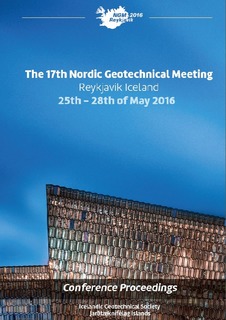| dc.contributor.author | Górniak, Joanna | |
| dc.contributor.author | Tankéré, Marie | |
| dc.contributor.author | Delmas, Philippe | |
| dc.contributor.author | Barral, Camille | |
| dc.contributor.author | Watn, Arnstein | |
| dc.contributor.author | Hyrve, Oddvar | |
| dc.contributor.author | Dahl, Allan | |
| dc.date.accessioned | 2017-11-22T17:50:50Z | |
| dc.date.available | 2017-11-22T17:50:50Z | |
| dc.date.created | 2017-11-06T11:36:08Z | |
| dc.date.issued | 2016 | |
| dc.identifier.isbn | 978-9935-24-002-6 | |
| dc.identifier.uri | http://hdl.handle.net/11250/2467654 | |
| dc.description.abstract | The determination of the interaction between geosynthetic reinforcement and granular soils is one of the key factors in the design of mechanically stabilised earth structures. Only a few experimental investigations dealing with the interaction of geosynthetics and expanded clay LWA can be found in literature. Large-scale pull-out tests were carried out in order to determine the interface coefficient of friction and the pull-out strength under low normal load in the framework of the development of a new type of geotechnical structure. The project was undertaken to design and evaluate a reinforcement product embedded in expanded clay LWA 10/20 mm. Three different geosynthetics were tested under low normal loads using an anchorage box. Geosynthetics of two meters length and one meter width were embedded between two 40 cm thick expanded clay LWA layers. The samples were instrumented with displacement transducers distributed along the sample. A force transducer enabled the measurement of the pull-out force. The tests have shown a direct relationship between the geosynthetic products of opened or closed geometry and the diameter of the expanded clay LWA grain size (10/20mm) on the obtained pull-out force. Considerably higher anchorage strength and interface coefficient of friction are obtained for geosynthetic products of opened geometry (geogrids). Also the influence of geosynthetic stiffness on the pre-peak pull-out behaviour is discussed in the paper. The observations also suggest that the obtained results on a narrow particle size distribution are not necessarily transferable to conventional soils. | nb_NO |
| dc.description.sponsorship | Aknowledgements.The research project TeMaSi has been supported by the European Commission (Eureka label) and funded by the FFN (Norway) and Oseo (France). | nb_NO |
| dc.language.iso | eng | nb_NO |
| dc.publisher | The Icelandic Geotechnical Society | nb_NO |
| dc.relation.ispartof | Proceedings of the 17th Nordic Geotechnical Meeting | |
| dc.subject | MSE structure | nb_NO |
| dc.subject | Expanded clay LWA | nb_NO |
| dc.subject | Geosynthetics | nb_NO |
| dc.subject | Pull-out tests | nb_NO |
| dc.subject | Interface coefficient of friction | nb_NO |
| dc.title | Determination of pull-out strength and interface friction of geosynthetic reinforcement embedded in expanded clay LWA | nb_NO |
| dc.title.alternative | Proceedings of the 17th Nordic Geotechnical Meeting, Reykjavík, 25-28 May 2016 | nb_NO |
| dc.type | Chapter | nb_NO |
| dc.description.version | publishedVersion | nb_NO |
| dc.rights.holder | © 2016 The authors and The Icelandic Geotechnical Society | nb_NO |
| dc.subject.nsi | VDP::Technology: 500 | nb_NO |
| dc.source.pagenumber | 205-214 | nb_NO |
| dc.identifier.cristin | 1511193 | |
| cristin.unitcode | 7401,30,30,0 | |
| cristin.unitname | Infrastruktur | |
| cristin.ispublished | true | |
| cristin.fulltext | original | |
